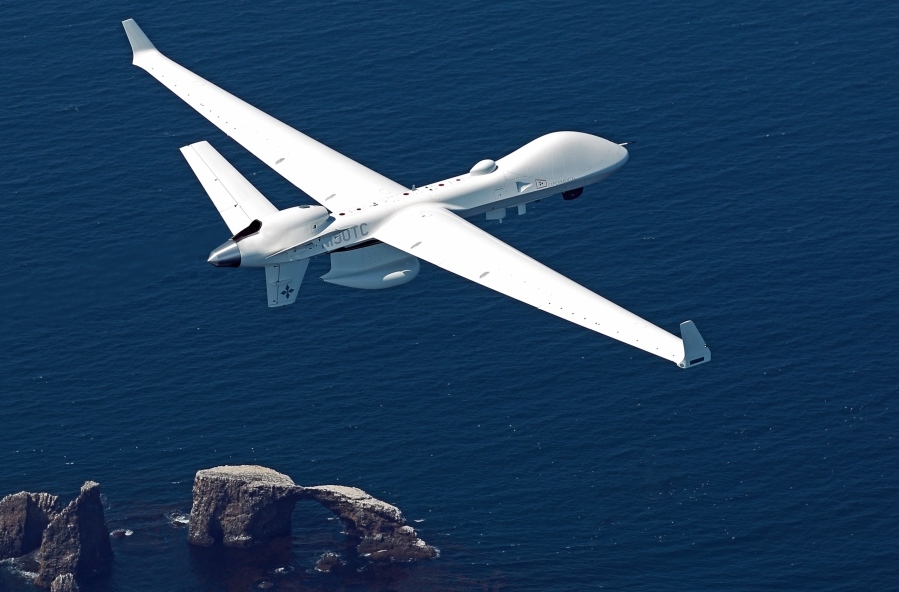LONDON CALLING
BY TIM MAHON
SKYGUARDIAN TICKS ALL THE BOXES
FOR CANADA’S DRONE REQUIREMENT
 When is a Predator not a Predator? When it’s a Protector. At least, that’s what springs to mind when looking at the world of unmanned aerial systems (UAS) or remotely piloted aircraft systems (RPAS). Actually, truth to tell, there is a reason for the changing nomenclature – but this column is not the place in which to detail, discuss and debate whether that is the right thing to do.
When is a Predator not a Predator? When it’s a Protector. At least, that’s what springs to mind when looking at the world of unmanned aerial systems (UAS) or remotely piloted aircraft systems (RPAS). Actually, truth to tell, there is a reason for the changing nomenclature – but this column is not the place in which to detail, discuss and debate whether that is the right thing to do.
To the naked eye, there are differences between Predator/Reaper – General Atomics – Aeronautical Systems Inc.’s (GA-ASI) iconic RPS which has dominated the world of unmanned systems, seemingly, for the last two decades – and Protector, which is the RAF’s designation for the MQ-9B that it is buying from GA-ASI to replace the current Reaper fleet (also bought from the same source).
Differences, yes – but huge similarities and the man in the street might (and frequently does) question why the United Kingdom is spending hundreds of millions of pounds on a new fleet when our TV screens and daily newspapers tell us our Reapers have been so effective in Afghanistan, Iraq and elsewhere.
The answer, of course, is that beauty is in the eye of the beholder. And in this case, Britain liked the look of what has now become Protector as far back as 2010, when then Prime Minister David Cameron announced the prospective purchase of a drone named Protector, which would replace Reaper around 2019, when funding for the latter was then due to run out.
This caused something of a furore at the time – initially because no pundit could find ‘Protector’ as it related to a UAS, RPAS, drone or unmanned system on Google – or any other search engine. Speculation ran rife. Was it an Israeli system? – a decent bet since Israel at the time had more experience in the development and operation of UAS than any other nation. That dominance has continued, albeit in slightly diluted form due to the huge influx of new players in the UAS space.
Was it, perhaps, going to be based on MANTIS which – mirabile dictu – would at least mean we were spending the money on a British system? Alternatively, would it perhaps emerge from whatever was happening at the time within the confines of the RAF’s SCAVENGER program – aimed at finding a medium altitude long endurance (MALE) UAS capable of fulfilling both ISR and strike missions. Even, perhaps, an outgrowth of the TELEMOS joint program with our partners across ‘La Manche,’ aimed at joint development of a MALE which, alas, fell foul of European politics and was ditched in favour of the slightly more pan-European EUROMale project.
WHY THE UK BOUGHT “PROTECTOR”
“Actually, it’s none of these,” said the government. “We’re going to buy an American system.” Placing this procurement in the context of the other decisions at the same time – the F-35 procurement, the eventual decision to fill the abysmal and glaring maritime patrol capability gap by procuring POSEIDON and, in parallel, agreeing to use American RIVET JOINT aircraft in the SIGINT role that the NIMROD decision had also left frighteningly unfulfilled – it makes perfect sense. From a political perspective. Thus proving what many pundits have always believed – this columnist included – that in the final analysis it is national and international political considerations that hold sway and exert an often disproportionate influence on procurement decisions.
That is a simple and general statement and therefore self-evidently not entirely true, however real the kernel of truth within. It is also unfair to the RAF, which argued for and is getting the aircraft it wants. Which, since the same airframe is being offered to Canada in the form of the SkyGuardian for Ottawa’s RPAS program, begs the question – why did they want it.
The answer boils down to two issues: capability and industrial benefit. The Protector provides the RAF with a vastly superior capability. Although Reaper/Predator was eminently capable when it appeared and led the pack sui generis, the simple fact is well over a decade has passed since then – and technology has advanced almost beyond recognition. Protector provides greater range and endurance, better performance, more payload and an infinitely more sophisticated sensor and communications suite.
In addition, GA-ASI has been very canny – in Australia, in Britain, in Belgium and elsewhere, in opening a dialogue with local industry and building an in-country ecosystem of suppliers, partners and protagonists for the company solution. Which is A Good Thing. Industrial benefits have long featured large in Canadian procurement decisions.
The candidacy of SkyGuardian as a future RCAF platform should, in theory, receive a lot of ticks in a lot of boxes for that reason alone. Add the superior, cutting-edge capability and the fact that the aircraft is certifiable – that is, it can readily be certified to fly in civilian airspace, thus hugely extending its potential utility – and you have a very strong contender. Now, over to the politicians ….
Tim Mahon is CDR’s European Bureau Chief. The views expressed here are his own and do not necessarily reflect a CDR editorial position.

